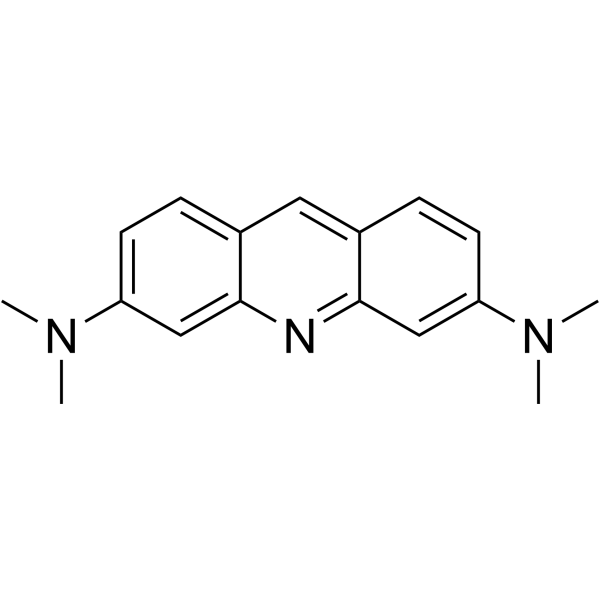吖啶橙,Acridine Orange base,75%
产品编号:Sigma-235474| CAS NO:494-38-2| MDL NO:MFCD00005029| 分子式:C17H19N3| 分子量:265.35
吖啶橙基是一种细胞渗透性荧光染料,可将生物体(细菌、寄生虫、病毒等)染色为亮橙色,并在适当条件下使用(pH=3.5,Ex=460 nm),将人类细胞区分为绿色,以便通过荧光显微镜进行检测。吖啶橙基与dsDNA(Ex=488,Em=520-524)结合时发出绿色荧光,与ssDNA(Ex=457,Em=630-644)或ssRNA(Ex=457,Em=630-444)结合时发红色荧光,也可用于细胞周期分析。
本网站销售的所有产品仅用于工业应用或者科学研究等非医疗目的,不可用于人类或动物的临床诊断或者治疗,非药用,非食用,
| 产品名称 | 吖啶橙 |
|---|---|
| 英文名称 | Acridine Orange base |
| CAS编号 | 494-38-2 |
| 产品描述 | 吖啶橙基是一种细胞渗透性荧光染料,可将生物体(细菌、寄生虫、病毒等)染色为亮橙色,并在适当条件下使用(pH=3.5,Ex=460 nm),将人类细胞区分为绿色,以便通过荧光显微镜进行检测。吖啶橙基与dsDNA(Ex=488,Em=520-524)结合时发出绿色荧光,与ssDNA(Ex=457,Em=630-644)或ssRNA(Ex=457,Em=630-444)结合时发红色荧光,也可用于细胞周期分析。 |
| 产品熔点 | 165ºC (dec.)(lit.) |
| 产品沸点 | 468.6±25.0 °C at 760 mmHg |
| 产品密度 | 1.2±0.1 g/cm3 |
| 产品闪点 | 237.2±23.2 °C |
| 精确质量 | 265.157898 |
| PSA | 19.37000 |
| LogP | 4.65 |
| 外观性状 | 棕色粉末 |
| 蒸气压 | 0.0±1.2 mmHg at 25°C |
| 折射率 | 1.710 |
| 体外研究 | 指南(以下是我们推荐的方案。该方案仅提供指南,应根据您的具体需要进行修改)。1.未固定细胞的DNA和RNA的差异染色:(1)使用发射滤光片和分色镜,在488nm处设置激发流式细胞仪,区分绿色荧光(在515-545nm处测量)和红色发光(最好在640或650nm以上测量)。(2) 将0.2-mL等分的原始细胞悬浮液转移到小玻璃或塑料管中(例如,2-mL或5-mL体积)。在冰上冷却。(3) 轻轻加入0.4 mL冰冷电池渗透溶液。等待15秒,使电池保持在冰上。(4) 轻轻加入1.2 mL冰镇吖啶橙染色液。在黑暗中将电池放在冰上。(5) 添加吖啶橙碱性染色液后2至10分钟内,在流式细胞仪中测量并记录细胞荧光。2.固定细胞的差异染色:(1a)对于悬浮培养或血液样本中的细胞:用冰凉PBS冲洗细胞一次,然后在∼106个细胞/mL。(1b)对于附着在组织培养板上的细胞:用胰酶消化法从烧瓶或培养板中收集细胞,将胰酶消化细胞与悬浮在培养基中的细胞(主要是分离的有丝分裂细胞和死细胞)混合,并用含有血清的培养基冲洗一次,使胰酶失活。将电池悬挂在冰冷的PBS中∼106个细胞/mL。(1c)对于从实体肿瘤中分离出来的细胞:冲洗不含任何用于细胞分离的酶的细胞,并将其悬浮在冰冷的PBS中∼106个细胞/mL。(2) 用巴斯德移液管将1mL细胞悬液转移到含有10mL冰凉70%乙醇的15mL锥形玻璃管中。固定单元格≥冰上2小时。(3) 离心管在300×g,4℃下5分钟。去除所有乙醇,用冰凉PBS冲洗细胞一次,并以<2×106个细胞/mL的密度悬浮在冰凉的PBS中。(4) 提取0.2 mL细胞悬液(≤ 2×105个细胞),然后转移到一个小管中(例如,2或5 mL体积)。在冰上冷却。(5) 添加0.4 mL冰凉渗透溶液。等待15秒,使电池保持在冰上。(6) 添加1.2 mL冰镇吖啶橙基染色液。将电池放在冰上。(7) 添加吖啶橙碱性染色液后2至10分钟内,在流式细胞仪中测量并记录细胞荧光。 |
| 储存条件 | 库房通风低温干燥,与食品原料分开存放 |
相关文档
化学品安全说明书(MSDS)
下载MSDS质检证书(COA)
相关产品
| WGK德国 | 3 |
|---|---|
| RTECS号 | AR7600000 |
|
Section1. IDENTIFICATION OF THE SUBSTANCE/MIXTURE Product identifiers Product name: Acridine Orange base CAS-No.: 494-38-2 Relevant identified uses of the substance or mixture and uses advised against Identified uses: Laboratory chemicals, Manufacture of substances Section2. HAZARDS IDENTIFICATION Classification of the substance or mixture Not a hazardous substance or mixture according to Regulation (EC) No. 1272/2008. This substance is not classified as dangerous according to Directive 67/548/EEC. Label elements The product does not need to be labelled in accordance with EC directives or respective national laws. Other hazards - none Section3. COMPOSITION/INFORMATION ON INGREDIENTS Substances Synonyms: Solvent Orange 15 3,6-Bis(dimethylamino)acridine Formula: C17H19N3 Molecular Weight: 265,35 g/mol Section4. FIRST AID MEASURES Description of first aid measures If inhaled If breathed in, move person into fresh air. If not breathing, give artificial respiration. In case of skin contact Wash off with soap and plenty of water. In case of eye contact Flush eyes with water as a precaution. If swallowed Never give anything by mouth to an unconscious person. Rinse mouth with water. Most important symptoms and effects, both acute and delayed To the best of our knowledge, the chemical, physical, and toxicological properties have not been thoroughly investigated. Indication of any immediate medical attention and special treatment needed no data available Section5. FIREFIGHTING MEASURES Extinguishing media Suitable extinguishing media Use water spray, alcohol-resistant foam, dry chemical or carbon dioxide. Special hazards arising from the substance or mixture Carbon oxides, nitrogen oxides (NOx) Advice for firefighters Wear self contained breathing apparatus for fire fighting if necessary. Further information no data available Section6. ACCIDENTAL RELEASE MEASURES Personal precautions, protective equipment and emergency procedures Avoid dust formation. Avoid breathing vapors, mist or gas. Environmental precautions Do not let product enter drains. Methods and materials for containment and cleaning up Sweep up and shovel. Keep in suitable, closed containers for disposal. Reference to other sections For disposal see section 13. Section7. HANDLING AND STORAGE Precautions for safe handling Provide appropriate exhaust ventilation at places where dust is formed.Normal measures for preventive fire protection. Conditions for safe storage, including any incompatibilities Store in cool place. Keep container tightly closed in a dry and well-ventilated place. Specific end uses no data available Section8. EXPOSURE CONTROLS/PERSONAL PROTECTION Control parameters Components with workplace control parameters Exposure controls Appropriate engineering controls General industrial hygiene practice. Personal protective equipment Eye/face protection Use equipment for eye protection tested and approved under appropriate government standards such as NIOSH (US) or EN 166(EU). Skin protection Handle with gloves. Gloves must be inspected prior to use. Use proper glove removal technique (without touching glove's outer surface) to avoid skin contact with this product. Dispose of contaminated gloves after use in accordance with applicable laws and good laboratory practices. Wash and dry hands. The selected protective gloves have to satisfy the specifications of EU Directive 89/686/EEC and the standard EN 374 derived from it. Body Protection Choose body protection in relation to its type, to the concentration and amount of dangerous substances, and to the specific work-place., The type of protective equipment must be selected according to the concentration and amount of the dangerous substance at the specific workplace. Respiratory protection Respiratory protection is not required. Where protection from nuisance levels of dusts are desired, use type N95 (US) or type P1 (EN 143) dust masks. Use respirators and components tested and approved under appropriate government standards such as NIOSH (US) or CEN (EU). Section9. PHYSICAL AND CHEMICAL PROPERTIES Information on basic physical and chemical properties a) AppearanceForm: solid b) Odourno data available c) Odour Thresholdno data available d) pHno data available e) Melting point/freezingMelting point/range: 165 °C - dec. point f) Initial boiling point and no data available boiling range g) Flash pointno data available h) Evaporation rateno data available i) Flammability (solid, gas) no data available j) Upper/lowerno data available flammability or explosive limits k) Vapour pressureno data available l) Vapour densityno data available m) Relative densityno data available n) Water solubilityno data available o) Partition coefficient: n- no data available octanol/water p) Autoignitionno data available temperature q) Decompositionno data available temperature r) Viscosityno data available s) Explosive propertiesno data available t) Oxidizing propertiesno data available Other safety information no data available Section10. STABILITY AND REACTIVITY Reactivity no data available Chemical stability no data available Possibility of hazardous reactions no data available Conditions to avoid no data available Incompatible materials Strong oxidizing agents Hazardous decomposition products Other decomposition products - no data available Section11. TOXICOLOGICAL INFORMATION Information on toxicological effects Acute toxicity no data available Skin corrosion/irritation no data available Serious eye damage/eye irritation no data available Respiratory or skin sensitization no data available Germ cell mutagenicity Laboratory experiments have shown mutagenic effects. Carcinogenicity This product is or contains a component that is not classifiable as to its carcinogenicity based on its IARC, ACGIH, NTP, or EPA classification. IARC:No component of this product present at levels greater than or equal to 0.1% is identified as probable, possible or confirmed human carcinogen by IARC. Reproductive toxicity no data available Specific target organ toxicity - single exposure no data available Specific target organ toxicity - repeated exposure no data available Aspiration hazard no data available Potential health effects InhalationMay be harmful if inhaled. May cause respiratory tract irritation. Ingestion May be harmful if swallowed. SkinMay be harmful if absorbed through skin. May cause skin irritation. Eyes May cause eye irritation. Signs and Symptoms of Exposure To the best of our knowledge, the chemical, physical, and toxicological properties have not been thoroughly investigated. Additional Information RTECS: AR7600000 Section12. ECOLOGICAL INFORMATION Toxicity no data available Persistence and degradability no data available Bioaccumulative potential no data available Mobility in soil no data available Results of PBT and vPvB assessment no data available Other adverse effects no data available Section13. DISPOSAL CONSIDERATIONS Waste treatment methods Product Offer surplus and non-recyclable solutions to a licensed disposal company. Contaminated packaging Dispose of as unused product. Section14. TRANSPORT INFORMATION UN number ADR/RID: -IMDG: -IATA: - UN proper shipping name ADR/RID: Not dangerous goods IMDG: Not dangerous goods IATA:Not dangerous goods Transport hazard class(es) ADR/RID: -IMDG: -IATA: - Packaging group ADR/RID: -IMDG: -IATA: - Environmental hazards ADR/RID: noIMDG Marine pollutant: noIATA: no Special precautions for user no data available SECTION 15 - REGULATORY INFORMATION N/A SECTION 16 - ADDITIONAL INFORMATION N/A |









 浙公网安备 33010802013016号
浙公网安备 33010802013016号